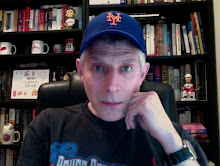TWENTY YEARS ON and I can still recall everything I did that day.
To be clear from the outset, I was -- relatively speaking -- outside the zone of physical danger, in an office building in midtown Manhattan. "Still too damn close," my cousin in Florida told me that evening.

So far away, yet close enough to see from an office window the World Trade Center towers burning and then watch from the same vantage point as the top of the north tower, suddenly enveloped by a billowing cloud of smoke, splintered and sank from view.
In 1975 I had the misfortune of being on a road running alongside New York's John F. Kennedy International Airport when an Eastern Airlines jet on final approach from New Orleans got caught in a microburst and crashed just short of the runway, killing 113 people.
Again, in relative terms, I was outside the zone of immediate danger. I still have nightmares inspired by that day. But it was an isolated, discrete, incident and, more importantly, a genuine accident, whereas the events of September 11, 2001 were not.
I'd arrived from work that morning after voting in the city's primary election. As I walked north on Madison Ave., people on the street were standing still and pointing south. I'd no idea what the commotion was about until I'd gotten upstairs, where my editor greeted me with, "You know what happened, right?"
I didn't until he directed me to a west-facing window, told me to lean out as far as I could then look south. There, the north tower stood, with a smoking hole in its façade.
As a reporter, one's immediate reaction is to observe and report. Not knowing what lay ahead, I ran from the office to the nearest drugstore to buy a disposable camera, believing the fire would be put out, the hole repaired and the incident would become part of the city's lore, like that day in 1945 when a fog-bound B-25 bomber
smashed into the Empire State Building.
The cheap camera's pictures turned out poorly, but in my mind's eye -- aided no doubt by the unprecedented media coverage -- they're crystal clear, as are the TV and radio news reports, the first-hand visual confirmation, the deepening dread as events unfolded, the not knowing which blow would be the last.
I pitched in on my newspaper's coverage that day, and on those that immediately followed.
Nearly 3,000 people died on what began as a sparkling clear September morning.
Somehow, those I knew who worked at the complex all survived, one because he found an intact stairway out of the south tower above the point of impact, another because he was fortuitously late for work.
Among the recognizable names of the dead was someone I'd known back in day camp, where he took an arrow to the eye in an archery accident. No longer his worst day.
Arriving home in Queens that evening, I found my girlfriend awaiting my emergence from the subway. We held each other tightly, staring westward at the plume of smoke across the sky, trying to comprehend the awfulness. We watched the news, talked and slept fitfully before I woke to head back in.
The Manhattan of September 12 was nightmarishly still. Subway traffic was halted south of Grand Central Terminal. Walking the last dozen blocks to my office, through that silent, desolated midtown at what now wasn't rush hour, was an experience I'll never forget.
In the years since, I've read novels that have tried and failed to capture the feeling of that day, and tried to watch movies that nail it so well I needed to turn them off. The emotions are hard to harmonize. So I fall back on the immediate documentation.
A saver of things since boyhood, a habit or human failing that's provided the backbone for this blog, I reflexively kept the newspapers published on that terribly quiet next day, and periodicals from the days and weeks that followed.
It seemed, and still seems, wrong to discard them, wrong to diminish the record of that terrible day. For 20 years, they've been in a cardboard box, one of many in a closet dedicated to my compulsion to retain printed matter, an urge undimmed by the evaporation of tangible media, newspapers and magazines, movies, music and books.
"Time it was and what a time it was, it was a time of innocence, a time of confidences. Long ago it must be, I have a photograph. Preserve your memories, they're all that's left you." -- Simon & Garfunkel.
-- Follow me on Twitter @paperboyarchive





I have a similar box packed away.
ReplyDeleteWe consumed news so differently then. Now everything is fleeting and disposable. Those papers, I'm glad I kept them. They matter. What they say matters. The effort to produce them matters.
Deletethnks
ReplyDelete